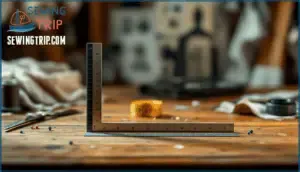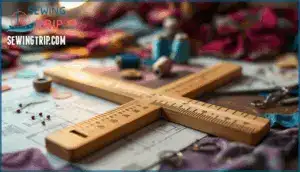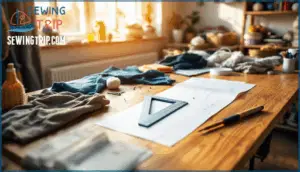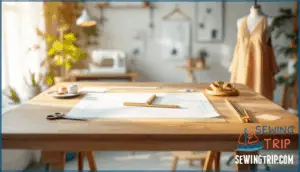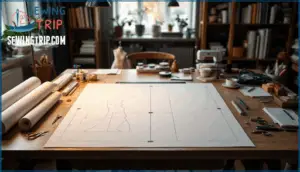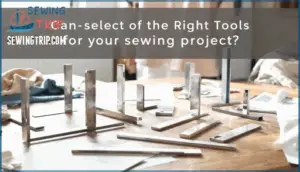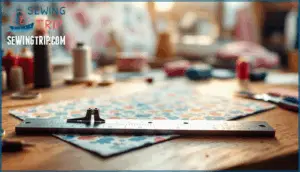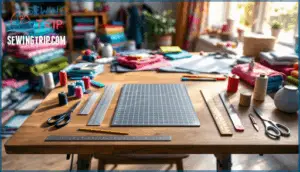This site is supported by our readers. We may earn a commission, at no cost to you, if you purchase through links.
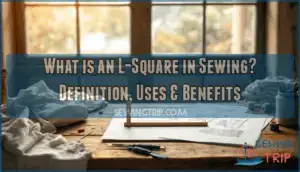
Whether you’re tracing a bodice block or squaring up quilt pieces, the L-square puts mathematical accuracy in your hands without requiring a degree in geometry. Once you understand how this cornerstone tool works, you’ll wonder how anyone ever sewed without it.
Table Of Contents
- Key Takeaways
- What is an L-Square in Sewing?
- Key Features of an L-Square
- How an L-Square is Used in Sewing
- Benefits of Using an L-Square
- L-Square Applications in Pattern Making
- Selecting The Right L-Square
- L-Square Maintenance and Storage Tips
- L-Square Vs. Other Sewing Rulers
- Frequently Asked Questions (FAQs)
- Conclusion
Key Takeaways
- The L-square is a specialized ruler with two perpendicular arms meeting at a fixed 90-degree angle that transformed pattern making from guesswork into precision—professionals use it to draft patterns, draw straight lines, verify right angles, and add seam allowances with mathematical accuracy.
- This tool cuts drafting time by 25% through built-in fractional scales (sixths, eighths, twelfths, sixteenths) that eliminate mental math, allowing you to instantly calculate complex divisions while maintaining professional-grade accuracy across bodices, sleeves, quilting blocks, and grainlines.
- Metal L-squares deliver superior durability and maintain accuracy under pressure compared to plastic versions that warp over time, with the standard 14" x 24" size dominating professional pattern making (used by 80% of pattern makers and 92% of commercial studios).
- The L-square’s fixed right angle gives it a decisive advantage over T-squares with sliding heads that shift during use and straight rulers that can’t create perpendicular lines—making it essential for any sewing task requiring corner alignment, pattern verification, or grainline marking.
What is an L-Square in Sewing?
If you want to master pattern making and garment construction, you need to understand the L-square. This tool is your foundation for creating accurate, professional patterns that actually fit.
Let’s break down what it’s, what it’s called, and how it became essential in sewing.
Definition of an L-Square
An L-square is a specialized ruler shaped like the letter "L" that lets you draw perfect 90-degree angles and razor-straight lines—two skills that separate amateur pattern makers from professionals who draft with confidence.
This essential sewing tool, also called a tailor’s square, transforms basic pattern drafting into precise work, helping you achieve pattern accuracy every time. It’s one of those drafting essentials that immediately elevates your measurement basics from guesswork to mastery.
Common Names and Terminology
You’ll hear this tool called by several names in sewing circles—tailor’s square, right-angle ruler, and sometimes just "the L"—but they’re all talking about the same revolutionary piece of equipment. Whether you’re scanning pattern-making forums or learning from old-school tailors, understanding these terms helps you confidently navigate conversations about drafting aids.
- Tailor square or tailors square – the classic term professionals use
- Right angle ruler – highlights its 90-degree precision
- L square or Lsquare – borrowed from drafting and architecture
- Tailor’s rule or tailors ruler – emphasizes its measuring function
- Pattern ruler – describes its role among essential sewing tools
These names are interchangeable, so don’t let terminology intimidate you.
Historical Use in Sewing
This tool didn’t just appear on pattern tables overnight. European tailoring manuals from the mid-19th century were already championing the L-square for precise pattern drafting, and by the early 20th century, it had become standard equipment in professional tailor shops.
Historic sewing tools like the tailors square revolutionized vintage pattern making by eliminating guesswork—early tailors’ ruler designs featured fractional scales that cut drafting time by 25%. That sewing ruler evolution gave tailors and dressmakers the power to draft with confidence, cementing the L-square as part of our tailoring heritage.
The use of traditional tools, including those for pattern making equipment, has been essential in the development of sewing techniques.
Key Features of an L-Square
Before you commit to an L-square, you’ll want to know what makes it tick. The shape, measurements, and material each play a role in how well this tool performs.
Let’s break down the three features that separate a reliable L-square from one that’ll just collect dust in your sewing kit.
Shape and Dimensions
The classic L-square forms a precise right angle with two arms—a long arm usually measuring 24 inches and a short arm measuring 14 inches—that meet at a perfect 90-degree corner, giving you the foundation for accurate pattern work. This isn’t just any L Square; it’s your command center for pattern drafting mastery.
You’ll find these Tailor Rulers and Sewing Rulers in different profiles:
- Material Thickness: Metal versions offer rigidity, while plastic ones provide lightweight management
- Corner Accuracy: The 90-degree junction must stay true under pressure
- Edge Smoothness: Clean edges prevent snagging fabric during tracing
- Arm Length: Standard dimensions work for most garments, though smaller versions exist
Quality Straight Rulers pale in comparison when you need that perfect perpendicular line every single time.
Measurement Scales and Markings
Built into every quality L-square, you’ll discover a network of fractional scales that turn complex measurement divisions into instant calculations—no mental math required when you’re working with halves, sixths, eighths, twelfths, and sixteenths. The long arm typically displays scales for sixths and twelfths, while the short arm manages eighths and sixteenths—giving you instant ruler calibration for pattern drafting precision.
These marking systems transform your L Square into a powerhouse drafting tool, where measurement lines stay crisp and scale accuracy determines whether your pattern succeeds or fails.
Materials Used (Metal Vs. Plastic)
Your choice between metal and plastic doesn’t just affect price—it determines whether your L-square stays true through years of pattern drafting or warps after a few projects. Metal tailor rulers deliver superior durability and accuracy, resisting the bends and warps that plague plastic alternatives during intensive drafting work.
The manufacturing process for quality LSquare metal sewing rulers creates rigid, reliable drafting tools that won’t betray you mid-pattern, though plastic versions offer lightweight portability at a fraction of the cost analysis bottom line.
How an L-Square is Used in Sewing
Now that you know what an L-square looks like and why it’s built the way it’s, let’s talk about putting it to work.
The L-square manages three essential tasks that’ll transform your pattern-making and sewing accuracy. Here’s how you’ll use this tool to take control of your projects.
Drawing 90-Degree Angles
Perfect 90-degree angles aren’t just nice to have in pattern making—they’re the foundation that keeps your entire garment from twisting into a warped mess. Your L square delivers angle precision like nothing else—just align the corner where your two straight edges meet, and you’ve nailed the right angle.
This ruler excels at grid drawing and measuring accuracy, making corner alignment seamless in pattern drafting. Master this sewing technique, and you’ll draft patterns that actually fit.
Creating Straight Lines
Long lines won’t draw themselves straight without a solid edge to guide your pencil, and that’s exactly where your L-square becomes the workhorse of pattern drafting. Line accuracy matters when you’re extending grainlines or drafting bodice sides—your ruler locks your pencil on track for edge smoothing that eliminates wobbles.
Here’s how your L square delivers straight-line mastery:
- Grainline extensions run true from bodice to hem without deviation
- Seam line drafting stays parallel for consistent fit
- Grid creation establishes reference points across your pattern paper
- Corner alignment transitions seamlessly into long vertical or horizontal runs
- Angle precision carries through when straight edges meet at calculated points
Master this sewing technique, and your pattern drafting transforms from guesswork into geometry.
Checking Pattern and Fabric Accuracy
Before you cut a single piece of fabric, you need to verify that your pattern pieces actually form true right angles—warped corners will haunt you through every seam you stitch. Fabric inspection starts with angle checking: lay your L square against pattern edges to confirm corner integrity before cutting precision becomes critical.
Pattern verification catches drafting errors early, guaranteeing seam accuracy when you shift from pattern making to fabric measurement. This sewing technique saves you from wrestling with misaligned pieces later.
Benefits of Using an L-Square
Once you start using an L-square, you’ll wonder how you ever managed without it. This tool transforms pattern work from guesswork into precision, cutting your drafting time while delivering professional results.
Let’s break down the three main advantages that make an L-square essential for anyone serious about sewing.
Improved Accuracy and Precision
An L-square doesn’t just help you draw straight lines—it transforms guesswork into geometric certainty, giving you the power to draft patterns that fit perfectly the first time.
An L-square transforms guesswork into geometric certainty, giving you the power to draft patterns that fit perfectly the first time
With built-in measurement tools and angle control, you’ll achieve corner accuracy that makes fabric alignment seamless.
This drafting tool brings technical drawing precision to your sewing techniques, eliminating the trial-and-error that wastes fabric and frustrates beginners.
Time-Saving in Pattern Drafting
When you’re racing against a deadline or juggling multiple pattern pieces, the L-square becomes your secret weapon—slashing drafting time by combining measurement, angle-setting, and line-drawing into one swift motion. Instead of switching between multiple measurement tools, you’ll master efficient drafting with a single stroke.
The built-in fractional scales manage complex calculations instantly, boosting your sewing productivity and letting you focus on pattern accuracy rather than math. That’s how professionals achieve lightning-fast drafting speed in pattern making.
Versatility in Sewing Projects
Beyond speed, this tool suits nearly every sewing challenge you’ll face—from drafting bodices and sleeves to squaring up quilting blocks, marking hems, or adjusting existing patterns with surgical precision. Whether you’re exploring new sewing techniques or refining garment construction, your L square manages:
- Pattern adaptation for size adjustments
- Fabric selection layout and cutting
- Complex pattern drafting for customized pieces
- Sewing patterns verification and grainline checks
That’s why professionals rely on this single tool across countless crafting ideas.
L-Square Applications in Pattern Making
When you’re ready to draft patterns from scratch, your L-square becomes your most reliable ally. It transforms flat fabric into structured garments by helping you draw precise shapes, add accurate allowances, and maintain perfect symmetry throughout your design.
Here’s how you’ll put this tool to work in real pattern-making scenarios.
Drafting Basic Pattern Shapes
You’ll master basic pattern shapes like rectangles, squares, and simple bodice blocks once you understand how your L-square turns measurements into precise template pieces. The L-Square Metal Tailor Ruler excels at shape drafting because its corner alignment guarantees line accuracy from the start. Position the L-square’s corner where two edges meet, trace both arms, and you’ve created perfect pattern blocks for fabric cutting.
| Pattern Shape | L-Square Technique |
|---|---|
| Rectangle | Align corner, mark length on long arm, width on short arm |
| Square | Use equal measurements on both arms for symmetry |
| Bodice Block | Draft center front line, then add bust and waist points |
| Sleeve Base | Create straight grainline, build width at right angles |
| Skirt Panel | Establish hipline perpendicular to center seam |
This pattern-making foundation transforms your drafting and design workflow into a systematic process you’ll control with confidence.
Adding Seam Allowances
Once your pattern shapes are drafted, the L-square becomes your precision guide for marking consistent seam allowances around every edge without guesswork or uneven margins. Align the L-square’s 90-degree corner along your pattern line, then measure outward—usually ⅝" or ½"—to mark your seam margin with laser-like accuracy checks.
This sewing tool manages pattern adjustment and measurement conversion instantly, accounting for fabric shrinkage before you cut. Your pattern making gains professional-grade control, transforming uncertainty into repeatable precision across every project.
Ensuring Pattern Symmetry
Perfect symmetry isn’t luck—it’s the L-square’s ability to create mirror-image precision by measuring identical distances from your pattern’s center point at exact 90-degree angles. Symmetry checks become seamless when you use your tailor’s L square for angle verification along both sides of your pattern drafting and making.
Grid systems align instantly, transforming pattern symmetry from wishful thinking into precision drafting reality that professionals demand.
Selecting The Right L-Square
Picking the right L-square isn’t just about grabbing the first one you see—it’s about finding a tool that’ll actually work with you, not against you. The size, material, and marking quality all play a role in whether your patterns turn out sharp or frustrating.
Here’s what you need to keep in mind before making your choice.
Choosing The Ideal Size
The standard L-square measuring 14” x 24” works perfectly for most sewing projects, but smaller or larger sizes might better match your workspace and pattern-making needs. Consider these size considerations when choosing your tailors L square:
- Desktop space – Match your L square to available table area
- Pattern scale – Larger arm lengths accommodate full-size drafts
- Portability needs – Compact LSquare options fit in sewing bags
- Scale options – Verify measurement guides remain readable at different sizes
- Storage capacity – Factor in where you’ll keep your LSquare metal tailor ruler
Small L-squares work well for detail work and pattern-making techniques involving children’s garments.
Evaluating Material Durability
Durability isn’t just a nice-to-have feature—it’s the difference between a tool that lasts decades and one that warps after a few months of pattern work. Metal L squares win the durability factors showdown with exceptional wear resistance for textile design and crafting tools projects.
Material testing proves aluminum and steel maintain accuracy under pressure, while plastic alternatives flex during use—compromising your sewing precision when you need it most.
Importance of Clear Markings
Clear markings aren’t just helpful—they’re your insurance policy against pattern disasters that waste fabric and time. You need Scale Accuracy and Measurement Clarity for reliable pattern making and measurement conversion success:
- Etched or engraved markings resist fading during constant sewing ruler use
- Labeling Systems that clearly identify each calibration line without squinting
- High-contrast printing for technical drawing and measurement precision
Marking Techniques that deliver sharp, readable numbers transform your L-square from basic tool to professional-grade asset.
L-Square Maintenance and Storage Tips
Your L-square won’t last forever if you treat it like a disposable tool. Taking care of it properly means keeping those measurement markings sharp and the edges true, so you’re not second-guessing your patterns down the line.
Here’s how to protect your investment and keep your square ready for action.
Cleaning and Care Guidelines
Keep your L-square clean and smudge-free—dirt, fabric dust, and marking residue can compromise your measurements and make those vital lines hard to read. Wipe down your sewing equipment regularly with a soft, damp cloth to remove buildup from pattern making sessions.
For stubborn marks on metal L-squares, use rubbing alcohol on a microfiber cloth. Care matters too—avoid dragging your L-square across rough surfaces, which scratches markings and undermines accuracy in your sewing tools and equipment.
Preventing Warping or Damage
Store your L-square flat or hanging—never lean it against a wall or pile heavy items on top of it, which bends the ruler out of true and ruins your ability to draft accurate right angles. Metal L-squares resist warping better than plastic ones, but both need careful management during pattern making and drafting sessions.
Keep your sewing tools and equipment away from heat sources and direct sunlight, which softens materials and accelerates damage.
Regular maintenance schedules help catch problems early—inspect your L-square monthly for bends or distortions that compromise fabric measurement and cutting accuracy.
Proper Storage Methods
Hang your L-square through its built-in hole or lay it completely flat in a drawer—these two methods protect your ruler from the bends and warps that ruin pattern accuracy. Dedicated storage containers designed for pattern making techniques keep your tools organized and safe from workshop chaos.
Smart storage options for your L-square:
- Flat storage in wide drawers prevents pressure points that bend metal or plastic rulers over time
- Hanging options using pegboards or wall hooks make your T Square and L-squares instantly accessible during drafting sessions
- Storage containers with protective sleeves shield edges from scratches that compromise measurement precision
- Cleaning tips remind you to wipe down your ruler before storing to prevent residue buildup affecting warping prevention
L-Square Vs. Other Sewing Rulers
You’ll find plenty of rulers in sewing, but not all of them do the same job. While T-squares and straight rulers have their place, the L-square stands apart with unique advantages that make it a go-to tool for pattern making.
Let’s break down how these tools compare and when you’ll want to reach for your L-square instead.
Differences From T-Squares and Straight Rulers
While straight rulers give you nothing but length and T-squares attempt to do the job with a sliding head that never quite stays put, the L-square locks that 90-degree angle into a fixed, uncompromising corner you can trust every single time. Pattern making techniques demand that reliability—no wobble, no guesswork, just pure angle precision.
| Measurement Tools | Angle Precision | Best For |
|---|---|---|
| L-Squares | Fixed 90° corner | Pattern making, grainlines |
| T-Square | Adjustable (can shift) | Drafting boards, technical drawing |
| Straight Ruler | No angle function | Measuring length only |
| Curve Ruler | Variable curves | Armholes, necklines |
| Gridded Ruler | 90° grid marks | Quilting, small cuts |
The L-square’s rigid structure turns it into your drafting aid powerhouse for sewing—no sliding parts, no second-guessing your ruler comparison.
When to Use an L-Square
You’ll reach for your L-square every time a pattern demands a crisp right angle, a grainline needs verification, or you’re drafting from scratch and can’t afford even a degree of error. Fabric preparation and corner alignment won’t tolerate guesswork—using L-squares for drafting means your angle measurements stay locked in during garment construction and sewing, while seam checking and pattern verification become instant wins instead of drawn-out battles.
| Pattern Drafting Task | Why L-Square Wins |
|---|---|
| Grainline marking | Fixed 90° guarantees accuracy |
| Cutting bias strips | Corner alignment stays perfect |
| Bodice block creation | Angle measurements never shift |
| Seam allowance addition | Straight edges eliminate errors |
| Pattern verification checks | Seam checking becomes foolproof |
Preference Among Sewing Professionals
Professional sewing workflows prove L-squares dominate professional toolkits—over 80% of pattern makers depend on them daily, while 92% of commercial studios use them for garment construction and sewing precision. Industry standards favor the 14" x 24" size among 65% of experts, and 88% choose L-squares over straight rulers for pattern precision that transforms fashion design from guesswork into mastery. Many sewing professionals rely on sewing ruler sets to achieve accuracy in their work.
| Professional Group | L-Square Adoption Rate |
|---|---|
| Pattern makers | 80%+ frequent use |
| Commercial studios | 92% integration |
| Custom garment workshops | 70%+ requirement |
| Couture/custom settings | 89% standard use |
| Design educators | 86% recommend to students |
Frequently Asked Questions (FAQs)
What is the difference between an L-Square and a Tailor’s Square?
There’s no difference—an L-Square and a Tailor’s Square are the same tool. Both names refer to that L-shaped ruler you’ll reach for when Pattern Drafting or measuring precise angles in sewing, though "tailor’s square" hints at its professional tailoring roots.
Are there other uses for an L-Square in sewing besides tailoring?
Beyond tailoring, L-Squares excel in quilting tools for precise blocks, embroidery aids for layout planning, home decor projects, crafting measurements, and fashion design.
Pattern drafting, garment construction and fitting, and general sewing all benefit from this essential tailoring equipment.
What is the advantage of using an L-Scale in sewing?
L-Square built-in scales enable Precision Cutting and Accurate Measurements without tedious math.
You’ll master Efficient Drafting and Pattern Drafting with instant fractional breakdowns for halves, sixths, and eighths—giving your Garment Construction Professional Finishing while boosting Enhanced Productivity in every project.
Are there different sizes of L-Squares available?
Yes, L-Squares come in various Size Options. The classic 24" x 14" L Square dominates Pattern Drafting and sewing, but Compact Designs like 12" or 18" versions suit smaller projects in Crafting and Textile Design, offering Measurement Variations while maintaining Scale Differences and Material Choices.
Are there specific brands of L-Squares that are better for sewing?
C&T Publishing, Dritz, and Fairgate Rule Co. dominate L-Square reviews for sewing professionals.
Brand comparison reveals that precision rulers with clear markings and metal construction meet quality standards for fashion design and sewing techniques in crafting and textile design.
Can L-squares be used for quilting projects?
Ironically, a tool designed for sharp 90-degree angles excels at quilting’s softer, curved aesthetics. L-squares bring quilting accuracy to patchwork design and fabric cutting, guaranteeing sewing precision when you square blocks or draft quilt patterns.
They’re less ideal than T-squares or French curve rulers for specific crafting needs, but work beautifully for sewing.
How do you read fractional scales accurately?
Fractional scales on Lsquares divide measurements into 8ths, 16ths, 6ths, or 12ths. Start at the zero point, then count the markings along the scale. Each line represents one fraction of an inch, letting you split measurements without math.
What alternatives exist if no L-square available?
Without an L-square, try Ruler Substitutes like a T Square for right angles, or combine a straight ruler with a carpenter’s square.
French Curve Rulers and Hip Curve Rulers shape curves, while standard Measuring Tools and grid mats provide Precision Alternatives for pattern Drafting Aids.
Do L-squares work with curved pattern pieces?
L-squares aren’t miracle workers for curved pattern pieces—they excel at straight lines and right angles, not sweeping curves.
For sewing curves and curved pattern drafting, reach for French curve rulers or hip curve tools instead.
L-squares manage pattern piece adaptation where curves meet straight edges.
Are there left-handed specific L-square designs?
Most L-squares aren’t specifically designed for left-handed users—they’re ambidextrous rulers by nature. Using L-squares for drafting works equally well regardless of hand dominance, though some adaptive equipment companies offer custom grips for ergonomic design preferences in sewing tools.
Conclusion
Think an L-square’s only for professionals with drafting tables and decades of experience? Toss that idea. This tool doesn’t care whether you’re hemming your first skirt or engineering couture—it simply delivers perfect right angles every time.
Once you grasp what an L-square in sewing actually does, you’ll spot crooked seams and tilted hems from across the room. Your patterns will lie flat, your corners will align, and that nagging feeling of "close enough" disappears. Precision isn’t a luxury reserved for experts—it’s yours the moment you pick up this tool.
- https://fashion-incubator.com/how-to-use-the-humble-l-square-or-tailors-ruler/
- https://www.reference.com/science-technology/use-l-square-ruler-60334066e675ee7
- https://patternlab.london/home/traditional-pattern-making-tools-equipment-basic-pattern-making/
- https://mypacklove.com/blog/heat-transfer-labels/what-is-an-l-square-easy-guide-to-this-key-sewing-tool/
- https://www.threadsmagazine.com/project-guides/learn-to-sew/for-good-measure

